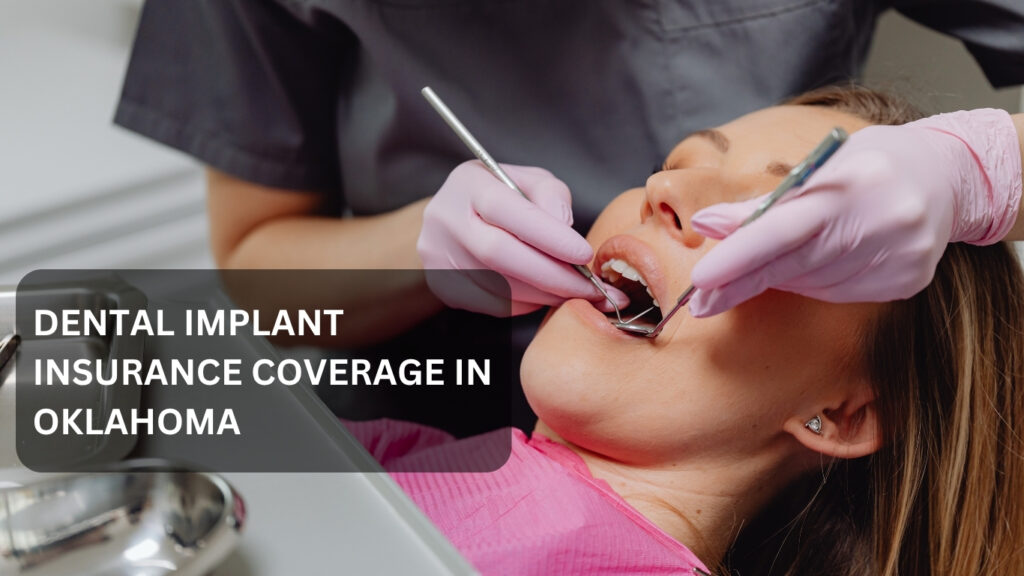Navigating dental insurance can feel overwhelming, especially when trying to understand what’s covered versus what leaves you paying out of pocket. In Oklahoma, dental plans vary widely by provider and plan type, but the basics remain fairly consistent across the board.
Most dental insurance coverage in Oklahoma is structured around three tiers of care: preventive, basic, and major services. Whether you’re getting routine cleanings, a filling, or a more complex procedure like a crown or implant, your coverage depends on the procedure type, your plan, and sometimes even your provider’s network.
Knowing the details upfront is key to avoiding surprise costs. Whether you’re shopping for your first plan or reviewing your current one, this guide breaks down exactly what you need to know—from fillings and crowns to implants and beyond.
What Dental Insurance Covers in Oklahoma: An Overview
So, what dental insurance covers in Oklahoma? While every plan is a bit different, most follow a similar structure built around the types of dental procedures you might need:
Preventive, Basic, and Major Services Defined
- Preventive Care: This includes cleanings, exams, x-rays, and sometimes fluoride treatments. Most plans cover these at 100% with no deductible—because prevention is cheaper than treatment.
- Basic Services: Fillings, extractions, and sometimes root canals fall into this category. Coverage is typically 70–80% after your deductible.
- Major Services: Crowns, bridges, dentures, and occasionally dental implant insurance coverage fall here. These are more costly and usually covered at 50% or less, often with waiting periods.
Coverage Levels by Plan Type (HMO, PPO, etc.)
- PPO Plans: More flexibility with provider choices. Coverage is generally broader, but premiums and out-of-pocket costs may be higher.
- HMO Plans: Lower premiums, but you must use in-network dentists. Often more restrictive with specialist referrals and major procedures.
- Discount Plans: These aren’t true insurance but offer reduced rates with participating dentists.
Understanding these tiers and plan structures helps you make better choices—and avoid overpaying for care you could have partially or fully covered.
Are Fillings Covered by Dental Insurance in Oklahoma?
If you’re dealing with a cavity, you’re probably wondering: are fillings covered by dental insurance in Oklahoma? The good news—yes, in most cases, they are.
Types of Fillings and Coverage Breakdown
Dental insurance typically covers amalgam (silver) and composite (tooth-colored) fillings under the basic services category. This means they’re usually covered at around 70% to 80% after you meet your deductible. Some plans may only fully cover silver fillings on back teeth, with composite fillings subject to additional out-of-pocket charges.
Common Limitations and Out-of-Pocket Costs
Even when fillings are covered by dental insurance, there are a few things to keep in mind:
- Frequency limits: Some plans only cover a filling on the same tooth once every few years.
- Material restrictions: Higher-end or cosmetic materials may not be fully covered.
- Deductibles: You’ll likely have to pay a deductible before your coverage kicks in.
Understanding these limitations can help you better anticipate your bill and plan your care accordingly.
Crowns, Root Canals & Bridges: Coverage for Major Procedures
When a tooth is damaged or severely decayed, simple fillings may not be enough. That’s when major procedures like crowns, root canals, or bridges come into play. These treatments are more expensive, but many dental insurance plans in Oklahoma provide at least partial coverage.
What’s Typically Covered
- Crowns: Often covered at 50%, crowns are used to restore damaged teeth. However, some policies may only cover certain types (e.g., metal over porcelain, not all-ceramic).
- Root Canals: Typically categorized under basic or major services depending on the tooth involved. Front tooth root canals are often covered at a higher rate than molars.
- Bridges: Used to replace missing teeth, bridges are almost always considered major dental procedures and covered at 50% or less, usually with a waiting period.
Coverage Percentages and Waiting Periods
Most insurance providers have a waiting period (often 6 to 12 months) before they cover major dental procedures. This is to prevent patients from signing up only when they need expensive treatment.
Which Plans in Oklahoma Cover These Procedures?
Many PPO plans from major providers in Oklahoma offer crown and bridge coverage after the waiting period. For more comprehensive support, consider working with a provider like Coleen Vache Healthcare, which can guide you toward policies that match your procedure needs.

Dental Implant Insurance Coverage in Oklahoma
Dental implants are one of the most effective solutions for replacing missing teeth—but they’re also among the most expensive. If you’re considering this route, understanding your dental implant insurance coverage in Oklahoma is essential.
Are Implants Covered by Most Dental Insurance Plans?
Traditionally, many dental insurance plans excluded implants, labeling them as elective or cosmetic. However, times are changing. Some newer plans—especially PPOs—partially cover implants under major services, typically at 50%, and often with a 12-month waiting period. Still, full coverage is rare.
Even when implants are included, coverage often applies to certain parts of the procedure (like the crown), while other components (such as bone grafts or surgical placement) may be out-of-pocket.
Alternatives Like Bridges or Partials
Because implants are costly, insurers often recommend bridges or partial dentures as lower-cost alternatives. These are more commonly covered and come with fewer exclusions. However, they may not offer the same durability or natural feel.
Cost vs. Coverage Analysis
The average cost of a single implant can range from $3,000 to $5,000. With partial coverage, you might still be paying $1,500 to $2,500 out-of-pocket. Be sure to read the fine print of any plan and compare implant coverage closely if this procedure is in your future.
For help finding plans that offer better implant benefits, services like Coleen Vache Healthcare can help you evaluate and compare your options across providers.
Cosmetic vs. Medically Necessary: What’s Usually Excluded
Not all dental procedures are created equal in the eyes of insurance providers. While medically necessary treatments often qualify for coverage, cosmetic enhancements usually don’t fall under standard dental insurance coverage in Oklahoma.
Veneers, Whitening, and Elective Procedures
Most dental insurance plans specifically exclude veneers, teeth whitening, and other purely cosmetic services. These treatments are considered elective—designed to improve appearance rather than oral health. As a result, they are typically 100% out-of-pocket expenses.
Other exclusions may include:
- Orthodontic treatments for adults (unless you purchase a supplemental orthodontic rider)
- Cosmetic bonding for minor chips or reshaping
- Tooth-colored crowns or fillings on back teeth (unless deemed medically necessary)
Exceptions and Supplemental Coverage Options
There are some exceptions. For instance, a veneer or bonding procedure might be covered if it’s required due to an accident or oral trauma, not just for aesthetic reasons.
Additionally, some plans allow add-on cosmetic or supplemental dental coverage for a higher premium. These can provide partial reimbursement for treatments like whitening or adult orthodontics, though they’re less common.
Understanding the difference between a dental insurance procedure that’s medically necessary versus cosmetic can help avoid surprises and keep expectations realistic when planning treatment.

Best Practices for Maximizing Dental Coverage in Oklahoma
Getting the most out of your dental coverage in Oklahoma isn’t just about choosing the right plan—it’s also about knowing how to use it wisely throughout the year.
Annual Maximums, Deductibles, and Waiting Periods
- Annual maximums (usually $1,000–$2,000) cap what your insurer will pay each year. If you’re planning multiple procedures, time them across benefit years if possible.
- Deductibles typically range from $50 to $150 and must be met before coverage kicks in for anything beyond preventive care.
- Waiting periods can delay access to basic or major services, especially for new enrollees—so plan ahead if you anticipate needing crowns, implants, or bridges.
In-Network vs. Out-of-Network Dentists
Using in-network providers can significantly reduce out-of-pocket costs. PPO plans often cover out-of-network visits too, but at a lower rate. HMO plans usually require you to stay in-network to receive any benefit.
Ask your provider:
- Is my dentist in-network?
- What’s the coverage difference if I go out-of-network?
- Are pre-authorizations needed for certain procedures?
These simple checks can help you avoid surprise bills and make better use of your benefits.
With dozens of providers offering various tiers of dental plans, comparing your options in Oklahoma comes down to balancing coverage, cost, and care needs. Whether you’re looking for full-service plans or something basic, there’s a fit for every budget.
Top Providers and What They Cover
Several national and regional companies offer solid dental insurance coverage in Oklahoma, including:
- Delta Dental: Known for a broad network and flexible PPO options. Often includes coverage for fillings, crowns, and even some implant procedures.
- Cigna Dental: Offers tiered plans with strong preventive coverage and options for major services.
- Humana: Provides affordable monthly premiums with access to both HMO and PPO models.
- Guardian and MetLife: Frequently recommended for family plans or employer-based group coverage.
Each of these providers has different strengths—some have better networks, while others offer more generous annual maximums or shorter waiting periods.
Tips for Choosing the Right Plan for Your Needs
- If you’re focused on preventive care, a low-cost HMO plan may be enough.
- Planning for crowns, implants, or root canals? Look for PPOs with major dental insurance procedure coverage.
- Don’t overlook waiting periods, deductible amounts, and whether your preferred dentist is in-network.
Consulting a licensed agent—or services like Coleen Vache Healthcare—can help you compare the fine print, spot hidden limitations, and find the best value for your specific dental health needs.
Final Thoughts: Making Sense of Dental Insurance in Oklahoma
Dental insurance can feel complicated, but with the right information, it becomes much easier to navigate. Whether you’re booking a simple cleaning, getting fillings covered by dental insurance, or planning for more complex procedures like crowns or implants, understanding your benefits ahead of time helps you make informed choices and avoid costly surprises.
The key is knowing what your plan includes, what it doesn’t, and how to maximize those benefits year after year. From preventive care to dental implant insurance coverage, most plans offer a framework that can save you thousands if used wisely.
And if you’re still unsure which plan makes sense for you, working with a local expert like Coleen Vache Healthcare can help you confidently choose coverage that truly fits your needs, both today and in the long run.
FAQs
Does dental insurance in Oklahoma cover fillings and crowns?
Yes, most dental insurance plans in Oklahoma cover fillings and crowns, but the level of coverage varies. Fillings are usually considered basic services and covered at around 70–80% after the deductible. Crowns fall under major services and are typically covered at 50%, often with a waiting period.
Are dental implants covered by insurance in Oklahoma?
Dental implant insurance coverage depends on your plan. While many traditional plans exclude implants, some PPO plans now offer partial coverage, typically 50% for certain components like the crown or abutment. It’s important to check for waiting periods and coverage limitations.
What’s typically excluded in dental insurance plans in OK?
Most plans exclude cosmetic procedures like veneers, teeth whitening, and sometimes orthodontic care for adults. Higher-end materials or elective services may also be only partially covered or not covered at all unless deemed medically necessary.
Is cosmetic dental work like veneers ever covered?
Veneers are usually not covered, as they’re considered cosmetic. However, if they are required due to trauma or injury and serve a functional purpose, some plans may provide partial coverage. Always review your plan details or consult your provider.
How much does insurance pay for major dental procedures in Oklahoma?
Coverage for major dental insurance procedures like crowns, bridges, and dentures typically ranges from 40% to 50% after the deductible is met. These procedures often come with a 6–12 month waiting period, so plan accordingly.
Which Oklahoma dental insurance plans cover root canals and bridges?
Many PPO plans from providers like Delta Dental, Cigna, or Guardian cover root canals and bridges as basic or major services. Coverage percentages and waiting periods vary, so it’s best to compare plans based on your treatment needs and timelines.








